Results 7,251 to 7,260 of 12096
Thread: Anandtech News
-
08-19-17, 08:32 AM #7251
Anandtech: ADATA Launches XPG SX9000: 2.8 GB/s Seq. Read, Marvell Controller, Up to 1
ADATA has announced its new SSD aimed at the very high end of the market. The new flagship XPG SX9000 drives are based on the Marvell 88SS1093 BTB2 controller and are paired with Toshiba’s 2D MLC NAND flash memory. Later on, the company plans to switch to Toshiba’s 3D MLC NAND for a product that will succeed the SX9000 SSD series.
The ADATA XPG SX9000 SSDs use the Marvell 88SS1093 BTB2 controller, which sports three processor cores and 8 NAND channels, with 4 banks per channel for 32 targets in total. The IC is an improved version of the 88SS1093 with higher frequencies and performance to boost speeds of higher-end SSDs. The 88SS1093 BTB2 supports a Marvell’s third-generation ECC technology based on the LDPC algorithm and uses PCIe 3.0 x4 interface.

The new XPG SX9000 drives are to be available in 256 GB, 512 GB, and 1 TB configurations in the M.2-2280 form-factor. The SSDs use DRAM buffers for additional performance, and come with a very basic heat spreader to further prop up performance in systems that provide adequate cooling. Speaking of performance, ADATA promises up to 2.8 GB/s sequential read speed as well as up to 1.45 GB/s sequential write speed for the top-of-the-range 1 TB model. As for random read/write performance, ADATA lists 310K/240K IOPS for the most advanced model.
Reliability is another thing that ADATA is taking serious when it comes to the XPG SX9000. The drives are rated for up to 1 TBW (terabytes to be written) and two million hours MTBF, which in turn is coupled with a five-year warranty.
ADATA has not set recommended prices of the XPG SX9000 series just yet. What we do know is that the drives are hitting the shelves in the coming weeks and expect their prices to be competitive against the obvious rivals — the Samsung 960 Pro and the Samsung 960 Evo families of SSDs.ADATA XPG SX9000 Specifications Capacity 256 GB 512 GB 1 TB Model Number ASX9000NP-256GM-C ASX9000NP-512GM-C ASX9000NP-1TM-C Controller Marvell 88SS1093 BTB2 NAND Flash 2D MLC NAND Form-Factor, Interface M.2-2280, PCIe 3.0 x4, NVMe 1.2 Sequential Read 2700 MB/s 2800 MB/s Sequential Write 990 MB/s 1450 MB/s Random Read IOPS 200K IOPS 300K IOPS 310K IOPS Random Write IOPS 220K IOPS 220K IOPS 240K IOPS Pseudo-SLC Caching Supported DRAM Buffer Yes, capacity unknown TCG Opal Encryption No Power Management DevSleep, Slumber Warranty 5 years MTBF 2,000,000 hours TBW 250 TB 500 TB 1000 TB
Otherwise, as previously stated, ADATA is also looking at releasing 3D NAND versions of the drive farther down the line. 3D NAND has a number of advantages over 2D NAND, but it's not ideal for all possible applications at the moment, particularly due to its high density, which conflicts with the need for multiple NAND packages to maximize parallelism and performance on high-end SSDs. All things considered, this is why ADATA decided to go with a new Marvell controller as well as Toshiba’s 2D MLC NAND for the XPG SX9000 SSD. Eventually, the company promises to use the same controller for a high-end 3D NAND-powered drive, but that is something that is going to happen towards the end of the year at best.
Related Reading:
- ADATA Announces XPG Gammix S10: 3D TLC, SM2260, 1.7 GB/s Seq. Read, Radiator
- ADATA Announces The XPG SX7000 Series SSDs: Up to 1 TB, M.2, PCIe 3.0 x4
- ADATA Launches XPG SX8000: High-End M.2 NVMe SSD Featuring 3D MLC NAND
More...
-
08-19-17, 12:00 PM #7252
Anandtech: SilverStone Shrinks Depth of Strider Titanium PSUs: 180 mm, Up to 1.5 kW,
SilverStone has announced its new high-wattage 80 Plus Titanium PSUs for high-performance desktop computers. The new Strider Titanium power supplies are rated for up to 1500 W output. The main selling point of the new power supplies is their depth, which has been shrunk to 180 mm, making them compatible with smaller chassis and builds.
There is an ongoing trend towards miniaturization of all kinds of computers, whether they are mobile or stationary. Nowadays there are enthusiast-class Mini-ITX components (mainboards, PSUs, etc.) and therefore MSI’s recently launched X299M Gaming Pro Carbon AC high-end Micro-ATX motherboard supporting three graphics cards and 10 storage devices does not come as a surprise. Meanwhile, Micro-ATX cases sometimes cannot accommodate large high-wattage PSUs that are usually 220 mm long. As a result, as performance of Micro-ATX is growing, so is demand for smaller high-efficiency ~1 kW power supplies.
SilverStone is responding to this demand with its new ATX12V V2.4-compliant high-wattage Strider Titanium PSUs that comply with the 80 Plus Titanium requirements, are rated for 1100 W, 1300 W and 1500 W output and are 180-mm deep (or long, however you put it). To get the 80 Plus Titanium badge, a PSU is mandated to be at least 94% efficient under a 20%, 50% and 100% load as well as at least 90% efficient under a 10% load. The latter is particularly important for high-wattage PSUs because it helps to take advantage of energy efficiency of modern PC hardware even with a very powerful PSU.
Like the many advanced PSUs these days, the SilverStone Strider Titanium 1 kW power supplies feature a modular design and come with two EPS12V connectors to enable compatibility with 2P server/workstations platforms, as well as with contemporary high-end desktop motherboards such as those based on AMD’s X399 'Threadripper' and Intel’s X299 'Skylake-X' platforms. As for other types of connectors, the new Strider Titanium PSUs have eight 6-2-pin (8-pin) PCIe auxiliary power connectors for graphics cards (just in case you run four AMD Radeon RX Vega 64 boards), 16 SATA power plugs, six Molex power outputs, and one FDD connector. All cables are flat to ensure greater flexibility.SilverStone Strider Titanium 1kW Series Output Specifications SST1100-TI SST1300-TI SST1500-TI Rated Combined Rated Combined Rated Combined +3.3V 25 A 82.5 W 25 A 82.5 W 25 A 82.5 W +5V 22 A 110 W 22 A 110 W 22 A 110 W +12V 92 A 1104 W 108 A 1296 W 125 A 1500 W -12V 0.3 A 3.6 W 0.3 A 3.6 W 0.3 A 3.6 W +5Vsb 3 A 15 W 3 A 15 W 3 A 15 W Total Power 1100 W 1300 W 1500 W
SilverStone claims that the new Strider Titanium 1 kW PSUs can work 24/7 with 50? operating temperature and will be absolutely quiet under light loads when their 135-mm fan is off. Meanwhile, even under high loads, the noise levels of the PSUs will not exceed 36 dBA. As for reliability ratings, the new Strider Titaniums are speced for 100,000 hours MTBF. To ensure safety, the power supplies are equipped with over current, over power, over/under voltage, over temperature, and short circuit protection mechanisms.
The Strider Titanium SST-1100-TI, SST-1300-TI and SST-1500-TI are already listed by major retailers, including Newegg and others The most affordable model of the new Strider Titanium PSU has MSRP of $299.99/€269.90, whereas the highest-performing 1.5 kW model has suggested retail price of $399.99/€345.50. Meanwhile, the mid-range SST1300-TI is priced at €288.90 in Europe. All new PSUs are covered by a five-year warranty.SilverStone Strider Titanium 1kW Series Connectivity Specifications Connector type SST1100-TI SST1300-TI SST1500-TI ATX 24 Pin 1 EPS 4+4 Pin 2 PCIe 6+2 Pin 8 SATA 16 4P Molex 6 Floppy 1
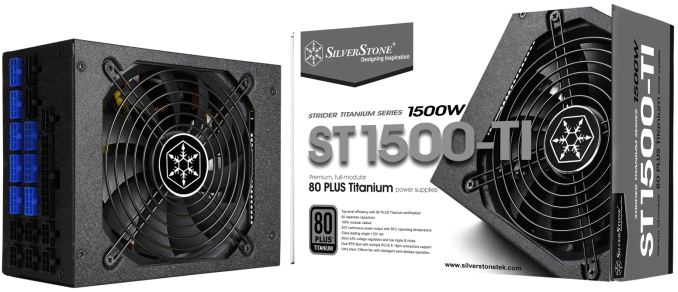
Gallery: SilverStone Strider Titanium 1kW Series





Related Reading:
- Enermax Shrinks Depth of Platimax D.F. 80 Plus Platinum 1200 W PSU to 6.3”/16 cm
- Seasonic Demos PRIME Fanless Titanium: 600 W, 12-Year Warranty, 80Plus Titanium
- FSP Demonstrates Hydro PTM+ 1200 W: a Liquid-Cooled PSU with RGB LEDs
- SilverStone Launches SX800-LTI: SFX-L, 800 W, 80 Plus Titanium
More...
-
08-20-17, 11:11 AM #7253
Anandtech: Analyzing Falkor’s Microarchitecture: A Deep Dive into Qualcomm’s Centriq
Developing a custom microarchitecture is difficult. Even with all the standards in place and licensing an instruction set such as ARM, the actual development takes time and the right people to put together, then the infrastructure to deploy at scale.
In the mobile space, we’ve seen custom cores – most notably from Apple – deviating from the regular ARM design, but also Samsung and Qualcomm are playing in that space. Qualcomm however is going one further by developing a custom core for the server and enterprise market, focusing purely on typical enterprise workloads. The current commercial ARM success in the data center comes from companies such as Cavium, who use ARM architecture licenses in a custom SoC. By developing its own high-performance core, Qualcomm is hoping to offer something different in the data center, and they’ve lifted the lid on a good chunk of the core.
More...
-
08-21-17, 05:05 AM #7254
Anandtech: Intel Launches 8th Generation Core CPUs, Starting with Kaby Lake Refresh f
This year has been enjoyably eventful for processor releases. Intel launched their 7th Generation processors, Kaby Lake, in January. Then we had AMD release their new high-performance microarchitecture in Ryzen, EPYC and Threadripper. Intel then launched their Skylake-SP Xeon Scalable Platform, based on an upgraded 6th Generation core design, and we’re expecting new AMD APUs for mobile later this year.
And adding to that list this morning is once again is Intel. Today the company is launching its new 8th Generation family of processors, starting with four CPUs for the 15W mobile family. The launch of these processors was perhaps spoiled by Intel jumping the gun a few days ago and listing the processors on its own public price list, but also we have started to see laptop and mobile designs being listed at various retailers before the official announcement.
There are two elements that make the launch of these 8th Gen processors different. First is that the 8th Gen is at a high enough level, running basically the same microarchitecture as the 7th Gen – more on this below. But the key element is that, at the same price and power where a user would get a dual core i5-U or i7-U in their laptop, Intel will now be bumping those product lines up to quad-cores with hyperthreading. This gives a 100% gain in cores and 100% gain in threads.
Obviously nothing is for free, so despite Intel stating that they’ve made minor tweaks to the microarchitecture and manufacturing to get better performing silicon, the base frequencies are down slightly. Turbo modes are still high, ensuring a similar user experience in most computing tasks. Memory support is similar – DDR4 and LPDDR3 are supported, but not LPDDR4 – although DDR4 moves up to DDR4-2400 from DDR4-2133.
Another change from 7th Gen to 8th Gen will be in the graphics. Intel is upgrading the nomenclature of the integrated graphics from HD 620 to UHD 620, indicating that the silicon is suited for 4K playback and processing. During our pre-briefing it was categorically stated several times that there was no change between the two, however we have since confirmed that the new chips will come with HDMI 2.0/HDCP 2.2 support as standard, removing the need for an external LSPCON for this feature. Other than this display controller change however, it appears that these new UHD iGPUs are architecturally the same as their HD predecessors.Specifications of Intel Core i5/i7 U-series CPUs 7th Generation 8th Generation Cores Freq +
TurboL3 Price Cores Freq +
TurboL3 Price i7-7660U 2/4 2.5/4.0 GHz 4 MB $415 i7-8650U 4/8 1.9/4.2 GHz 8 MB $409 i7-7560U 2.4/3.8 GHz $415 i7-8550U 1.8/4.0 GHz $409 i5-7360U 2/4 2.3/3.6 GHz 3 MB $304 i5-8350U 4/8 1.7/3.6 GHz 6 MB $297 i5-7260U 2.2/3.4 GHz $304 i5-8250U 1.6/3.4 GHz $297
Fundamentally these are what Intel calls a ‘4+2’ silicon design, featuring four cores and GT2 integrated graphics, whereas the last generation used 2+2 designs. The 4+2 design was also used in the mainstream desktop processors, suggesting that Intel is using those dies now for their 15W products rather than their 45W+ products. That being said, Intel is likely to have created new masks and revisions for this silicon to account for the lower power window as well as implementing HDCP 2.2 support and other minor fixes.
Now by having quad-core parts in the 15W form factor, performance on the new chips is expected to excel beyond what has been available from the previous generation of Core i5-U and Core i7-U processors. However Intel and its OEMs have a tight balancing act to walk here, as 15W is not a lot of thermal headroom for a two core CPU, let alone a four core one. At the same time we have started to see the 15W U-series parts find their way into smaller and even fanless notebook designs, which are more prone to throttling under sustained workloads, and quad core CPUs in this segment could exacerbate the issue. However, for the larger 13-15-inch designs with active cooling, moving down from a 35W-45W quad core processor down to 15W will likely offer substantially better battery life during intense loading, should OEMs swap out H-series chips for the new U-series chips in their designs.
Intel’s big aim with the new processors is, as always, to tackle the growing market of 3-5+ year old devices still being used today, quoting better performance, a better user experience, longer battery life, and fundamentally new experiences when using newer hardware. Two years ago Intel quoted 300 million units fit into this 3-5+ year window; now that number is 450 million.
Intel provided this shot of a wafer containing these new refresh dies, which by my math gives 22 x 32.7 dies per wafer. Giving some margin for die spacing, this correlates to a 13.6 x 9.1 mm die, at 124 mm2 and 478 full dies per wafer. At a tray cost of $409 per Core i7, and running at ~124mm2 per die, that makes an interesting metric of $3.30 per square millimeter. Intel no longer officially provides die sizes or transistor counts, though a list of $/mm2 would be interesting to compile - for reference some of the high-end Xeons push north of $19/mm2.
Kaby Lake Refresh? 14+? Where’s my Coffee (Lake)?
So despite Intel launching its 7th Generation family in January, today Intel is formally launching the 8th Generation only eight months later. To explain why Intel is breaking the usual 12-18 month cadence for the generation product, it comes down to product positioning.
In the past we are used to a new numbered generation to come with a new core microarchitecture design. But this time Intel is improving a core design, calling it a refresh, and only releasing a few processors for the mobile family. We expect that Intel’s 8th Generation will eventually contain three core designs of product on three different process design nodes: the launch today is Kaby Lake Refresh on 14+, and in the future we will see Coffee Lake on 14++ become part of the 8th Gen, as well as Cannon Lake on 10nm.
Now the Generation name is no longer in direct correlation with underlying core microarchitecture or lithography process. This is going to confuse some users and anger others, although Intel’s official line is along the lines of the fact that lithography process nodes are harder to optimize, smaller nodes benefit in yield from smaller cores and as such their product portfolio has to expand beyond traditional naming in order to provide the appropriate product and the appropriate price point.Intel's Core Architecture Cadence (8/20) Core Generation Microarchitecture Process Node Release Year 2nd Sandy Bridge 32nm 2011 3rd Ivy Bridge 22nm 2012 4th Haswell 22nm 2013 5th Broadwell 14nm 2014 6th Skylake 14nm 2015 7th Kaby Lake 14nm+ 2016 8th Kaby Lake Refresh
Coffee Lake
Cannon Lake14nm+
14nm++
10nm2017
2017?
2018?9th Ice Lake?
...10nm+ 2018? Unknown Cascade Lake (Server) ? ?
In our pre-briefings, Intel only mentioned Coffee Lake in the context of the fact that today’s launch is not Coffee Lake. Because media were expecting this to be Coffee Lake (and expecting it to be a desktop processor launch), the question ‘is this Coffee Lake’ was actually asked several times, and the answer had to be repeated. These four new CPUs are still Kaby Lake CPUs built on the same 14+ technology, with minor updates, and bringing quad cores to 15W.
So when is Coffee Lake on 14++ (or Cannon Lake) coming? Intel only stated that other members of the 8th Generation family (which contains Kaby Lake Refresh, Coffee Lake and Cannon Lake) are coming later this year. Desktop will come in the autumn, and additional products for enterprise, workstation and enthusiast notebooks will also happen. As for today's 8th Generation U-series announcement, Intel tells us that we should start seeing laptops using the new CPUs hit the market in September.
Update: Along with the product specs for the new mobile SKUs, Intel has also uploaded the new box art for the desktop 8th Gen Core parts to their website. The boxes confirm, among other things, that once these desktop parts will launch they'll have 6 cores (with HT for the i7) and require 300 series motherboards.
Gallery: Intel 8th Generation Launch Slide Deck





Related Reading- Unannounced 8th Generation Core 15W U-Series CPUs Appear on Intel’s Public Price List
- Intel to Announce 8th Generation Core Processors on August 21st
- Coffee Lake Not Supported by Intel’s 200-Series Motherboards
- Intel Officially Reveals Post-8th Generation Core Architecture Code Name: Ice Lake, Built on 10nm+
More...
-
08-21-17, 12:04 PM #7255
Anandtech: Hot Chips: Microsoft Xbox One X Scorpio Engine Live Blog (9:30am PT, 4:30p
This week it's the Hot Chips conference in Cupertino. We're sat nice and early, with the first talk today from Microsoft. John Sell, a Microsoft hardware veteran, is set to talk about the Scorpio Engine, found in the Xbox One X. It's practically the only talk this week where the slides were not given out early, so I wonder what will be discussed, especially given the large amount of interest in what the Scorpio Engine is. So never mind the eclipse, let's talk consoles.
More...
-
08-21-17, 06:18 PM #7256
Anandtech: Hot Chips: Intel Knights Mill Live Blog (4:45pm PT, 11:45pm UTC)
Another talk from Hot Chips, this time on Intel's Knights Mill (KNM). The Intel Knights family stems from their Xeon Phi product line, although KNM is a bit different, with machine learning specific changes. It's not a completely new Xeon Phi design, but Intel wants to go after the machine learning market. Today's talk will go into some of those changes. (We're battling some wifi here, so pictures may come later).
More...
-
08-21-17, 07:55 PM #7257
Anandtech: Silverstone Launches TOB03 ODD: 9.5-mm CD/DVD/BD/BDXL Burner
SilverStone has introduced its first ultra-slim ODD that can read and record CD, DVD, Blu-ray and BDXL media. The drive is not a technological breakthrough, but it is going to be one of a few 9.5-mm BD/BDXL-supporting ODDs on the market. Of course, SilverStone is primarily known for its cases, PSUs and coolers, so the launch of the TOB03 ODD demonstrates that the company sees demand for such products from those who buy its SFF chassis.
Optical discs have been losing popularity for years. Nowadays the vast majority of audio-visual content (games, music, movies, etc.) is distributed digitally via services like iTunes, Netflix, Origin and Steam. Due to the shrinking market of drives and discs, a number of ODD makers and optical media manufacturers ceased production and focused on other markets. However, a lot of people still own large collections of CDs, DVDs and Blu-ray discs which need something to access the media. Moreover, Blu-ray and Ultra HD Blu-ray formats still offer the highest quality 1080p and 4K movies due to massive bitrates that streaming or digital download services do not offer, due to network restrictions for most. As a result, while demand for ODDs in general is not high, it exists and there are people willing to pay for such drives.
From SilverStone’s point of view, these are people who buy its SFF PC cases, SFX PSUs and coolers for home theater PCs and then go to other suppliers for optical drives. From a business perspective, it makes a lot of sense for SilverStone to offer its customers premium ODDs in addition to what it already sells them. However, there is a problem. While SilverStone makes various products in-house, producing optical drives is not what it does and sourcing lasers, motors and other ODD components is sometimes tricky in a world where only a few companies produce them. Therefore, SilverStone had to find an OEM to manufacture the hardware. Apparently, there are only two companies on the planet that make 9.5-mm Blu-ray/BDXL burners: one is LG and another is Panasonic. The latter is the maker of the TOB03 and this is something that SilverStone does not seem to hide: the official photos of the drive clearly reflect that this is indeed the Panasonic/Matshita UJ272. The drive has been around for a while, but given the relatively slow evolution of ODDs in general, this is hardly a problem. Moreover, when it comes to availability of ultra-slim BD/BDXL burners, the more the merrier as right now their choice and supply are very limited. SilverStone's offering does not expand the former, but it clearly boosts the supply by making the drive available from the company's usual channels.

The SilverStone TOB03 (aka Panasonic UJ272) uses the SATA 3.0 interface (with a Slimline SATA connector) and can read and record CD (CD, CD-R, CD-RW, HS-RW, US-RW), DVD (DVD, DVD±R, DVD±R DL, DVD±RW, DVD-RAM) and Blu-ray (BD, BD-R SL/DL/TL/QL, BD-RE SL/DL/TL) discs. The drive has a 2 MB buffer underrun protection (which is lower compared to other high-end ODDs) and supports 6x CAV burning speed for popular BD-R SL/DL (25 GB/50 GB) media as well as 4x PCAV burning speed for BR-R TL/QL (100 GB/128 GB) discs. As for supported Blu-ray formats, both SilverStone and Panasonic declare Blu-ray and Blu-ray 3D, but not UHD Blu-ray (at least for now). Since SilverStone’s TOB03 comes in retail packaging only, the ODD always comes with a 12.7 mm bezel to be compatible with cases that support slim drives as well as a slimline SATA adapter featuring a flexible braided cable for easier installation (which contrasts to OEM drives from renowned makers that come without any cables in some regions).

SilverStone’s TOB03 ODD burner will be available from the company’s partners in the coming weeks. The company does not disclose anything about pricing, but since Panasonic’s UJ272 is available for $70 to $90 depending on the retailer, expect the TOB03 to be priced in the same ballpark.
Related Reading:
- Pioneer Announces Ultra HD Blu-ray Supporting BDR-S11J Drives
- Blu-ray Disc Association Completes Ultra HD Blu-ray Specification
Gallery: Silverstone Launches TOB03 ODD: 9.5-mm CD/DVD/BD/BDXL Burner





More...
-
08-21-17, 09:26 PM #7258
Anandtech: AMD Releases Radeon Software Crimson ReLive Edition 17.8.1
Today, AMD has released Radeon Software Crimson ReLive Edition 17.8.1, a unified driver supporting older products as well as RX Vega cards. This update follows last Monday’s RX Vega64 launch and accompanying RX Vega specific beta driver. In addition to unifying the Radeon Software driverset, 17.8.1 brings game support and a slew of bug fixes.
Featuring Driver Version 17.30.1051 (Windows Driver Store Version 22.19.666.1), Radeon Software 17.8.1 brings support for Agents of Mayhem, launched last week, and Bethesda’s Quake Champions Early Access, which starts on August 22nd. On the topic of Bethesda, 17.8.1 also includes a new optional component, unchecked by default: a download link to the Bethesda.net launcher. If selected, a Bethesda.net homepage link will be created in the Radeon Software Gaming tab, under the “Show Partner Programs” button.
Moving on to bug fixes, AMD has addressed a few FreeSync matters: stuttering in FreeSync displays when watching fullscreen video content, and flickering/brightness issues with certain Samsung FreeSync monitors. Similarly, AMD has resolved other playback-related bugs: HDCP error codes in certain protected content applications while playing Blu-ray content, and tearing or choppy playback when Enhanced Sync was enabled for video playback on desktop or YouTube playback in Google Chrome. Lastly, AMD has resolved intermittent HDMI signal loss in certain HDR enabled TVs.
Moving on to game fixes, AMD has resolved intermittent Grand Theft Auto V crashes, as well as extended load times in Forza Horizon 3. RX 380 crashes in Chapter 13 of Tekken 7 were also fixed.
A few known issues for RX Vega remain: WattMan still may not reach applied overclock states, and the Radeon Settings Gaming tab “Reset” option may enable “HBCC Memory Segment” instead of setting it to the default disabled state.
The updated drivers for AMD’s desktop, mobile, and integrated GPUs are available through the Radeon Settings tab or online at the AMD driver download page. More information on this update and further issues can be found in the Radeon Software Crimson ReLive Edition 17.8.1 release notes.
More...
-
08-21-17, 09:26 PM #7259
Anandtech: NVIDIA Brings Back Destiny 2 Bundle for GeForce GTX 1080 & 1080 Ti Cards
From today to September 5th (or while supplies last), NVIDIA is bringing back June’s Destiny 2 bundle for GTX 1080 and 1080 Ti cards, systems, and laptops, a week ahead of Destiny 2’s PC Beta launch on August 28th. As a reminder, eligible systems include NVIDIA’s own GeForce GTX Battlebox products. The bundle includes Destiny 2 at its October 24th launch date, as well as three in-game items: the Coldheart Exotic Rifle, Kill Tracker Ghost, and Salute emote. These items may also be redeemed by people who purchased the bundle in June.
The upcoming massively multiplayer online sci-fi first-person shooter, a concept Bungie previously described as a “shared world shooter”, will be preceded by an August 24th NVIDIA Game Ready driver. Additionally, Destiny 2 will support High Dynamic Range (HDR) and SLI, a result of NVIDIA's collaboration with Activision and Bungie. HDR itself will available to test during the PC Beta.
This latest iteration of the bundle does not mention Early Access codes for the PC Beta, although Bungie does state that Destiny 2 preorders through the Blizzard store come with Early Access. In context, Destiny 2 has an exclusive Early Access PC Beta on August 28th, with the general Open Beta running from the 29th to 31st. In any case, NVIDIA is also giving away Early Access codes in celebration of Gamescom, and will announce winners through GeForce Experience on August 25th.
As of August 2017, this is the only active NVIDIA promotional bundle. As before, Destiny 2 game codes may only be redeemed until 30 days after PC launch date.
Codes must be redeemed through GeForce Experience (3.2.2 or higher). After redeeming through GeForce Experience, Destiny 2 must be subsequently redeemed with a Blizzard account. Be sure to verify the participation of any vendors purchased from as NVIDIA likely will not give codes for purchases made from sellers that are not participating.
More...
-
08-22-17, 08:00 AM #7260
Anandtech: ASUS Announces B250 Expert Mining Motherboard: 19 Expansions Slots
ASUS has teased their first cryptocurrency mining board, the B250 Expert Mining. It’s full of expansions slots, with 19 to be exact, to pack in the most GPUs on a single system. This large number puts it at the top of the food chain for the quantity of PCIe slots suitable for mining duties. In order to support so many slots and lower the Return on Investment (ROI), ASUS implemented a unique setup for power with a Triple ATX12V (24-Pin), PCIe slot state detection, voltage stabilization capacitors for each slot, as well as using a mining specific BIOS for increased hash rates.
The reason for a shorter ROI here is the ability to use fewer parts for a given amount of graphics cards used. In other words, the outgoing cost will be less due to fewer systems needed to be built. Only one Motherboard, CPU, SSD, and set of RAM is required for 19 GPUs, saving money and lowering initial costs. According to ASUS, users are currently only able to utilize up to 16 cards due to a limit in GPU drivers. This is accomplished by using a mix of eight AMD and eight NVIDIA GPUs. Late in 2017, a new driver from AMD is supposed to launch enabling the full complement of 19 GPUs the motherboard can handle. When using more than 13 cards, the NVIDIA GPUs will need to use mining specific (P106 based) GPUs.
Of the 19 expansions slots, 18 are PCIe 3.0 x1, along with one full-length PCIe 3.0 x16 slot. ASUS separates the slots in three groups each with a dedicated 24-pin assigned to it for power. The top 24-pin covers slots 1-7 (includes the full-length slot), the middle header 8-13, with the last covering 14-19. There are also three Molex connectors for additional slot power. Along with separated power sources, each PCIe slot has its own dedicated capacitor to condition the voltage going to GPU.
Once the system is setup, upon boot miners are able to see a POST UI (power on in-screen image). The image shows a top-down view of the motherboard expansion slots indicating the status of each GPU. There are three states; Working, Error, and None. The slots working properly show up in green, those in error are in red, while unpopulated slots are gray. This seems like a good way for miners to get a quick ‘state of the union’ upon booting the system. ASUS provided a slide showing costs savings, as well as how to properly setup graphics cards on the Mining Expert (see the gallery at the end).
Specifications wise, the ASUS B250 Mining Expert is based on the B250 chipset with its LGA1151 socket supporting Intel 6th and 7th generation processors. Memory capacity is up to 32GB DDR4 in dual-channel mode supporting speeds up to 2400 MHz. Storage needs are handled by the four SATA3 ports while there is a total of six USB3.1 and 4 USB 2.0 ports. The rear panel I/O is pretty anemic as one would expect out of a mining board, but has the basics with two PS/2 ports, two USB 2.0 ports, four USB 3.0 ports, HDMI, Intel-based LAN (I219V Gigabit), and 8 channel audio jacks driven by a Realtek ALC887 codec. The CPU gets its power through a 6 phase DIGI+ VRM. Below is a complete specifications list:
ASUS has not released pricing at the time of publication. Sample allocation and motherboard partner allocation is 8/22. Public availability was not listed but should be expected soon.ASUS B250 Mining Expert Socket LGA 1151 Chipset Intel B250 Memory DDR4 x2, 2400 MHz PCIe x16 1 PCIe x1 18 VGA HDMI LAN Intel I219V Gigabit Audio Realtek ALC997, 8-ch SATA 6 Gb/s 4 USB 3.1 Gen 1(Back/Front) 4 / 2 USB 2.0 4 24-pin EATXPWER Headers 3 COM Header Yes Form Factor ATX, 12 x 9.1 in.
Gallery: ASUS B250 Mining Expert




Related Items:
- Gigabyte Announces H110-D3A Motherboard for Mining Rigs: The Mining Cart Rolls On
- Mining Cards Update: Zotac, Manli, and Biostar Products Formally Confirmed
- Biostar Goes Mining: New TB250-BTC PRO Motherboard and RX 470D Mining GPU
- ASUS & Sapphire Release Pascal & Polaris-based Cryptocurrency Mining Cards
More...
Thread Information
Users Browsing this Thread
There are currently 19 users browsing this thread. (0 members and 19 guests)




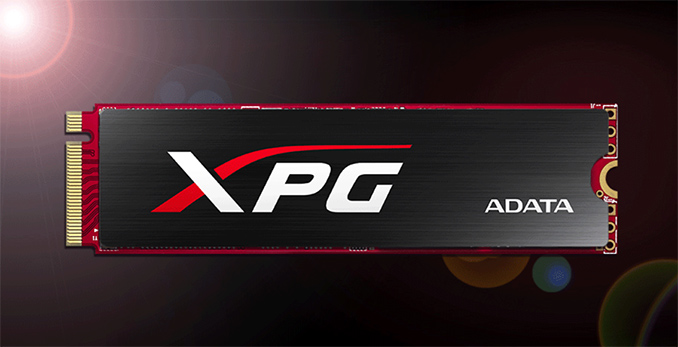

 Quote
Quote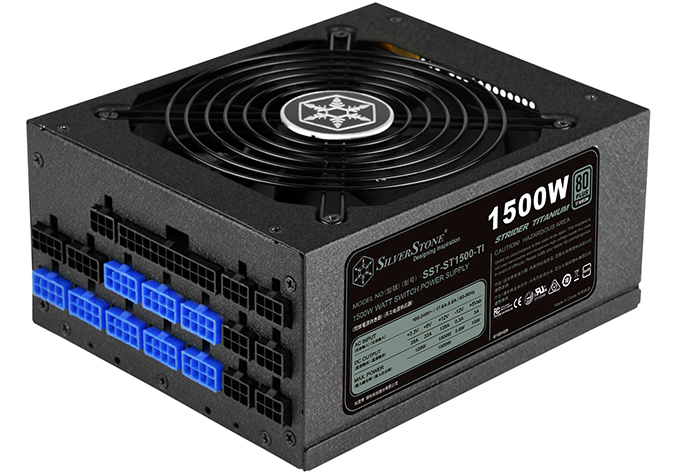

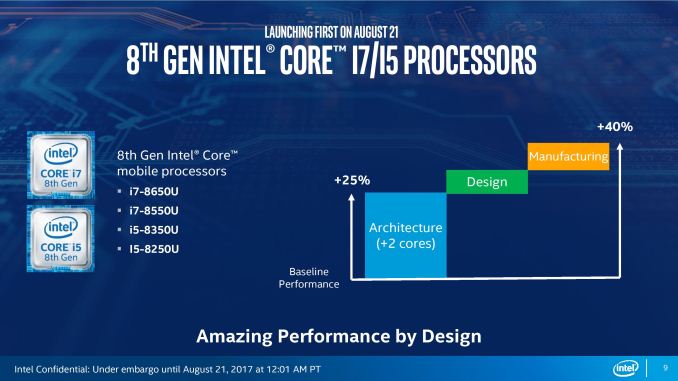
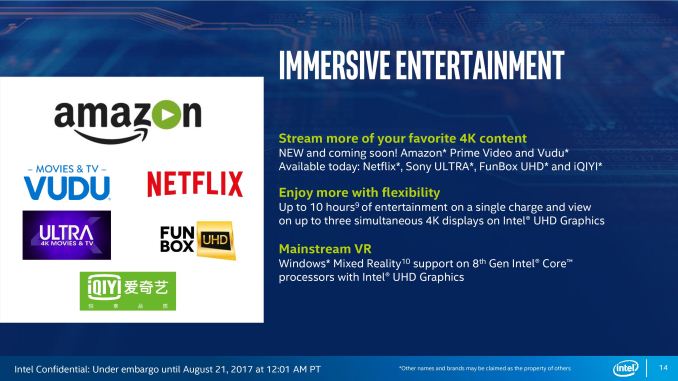
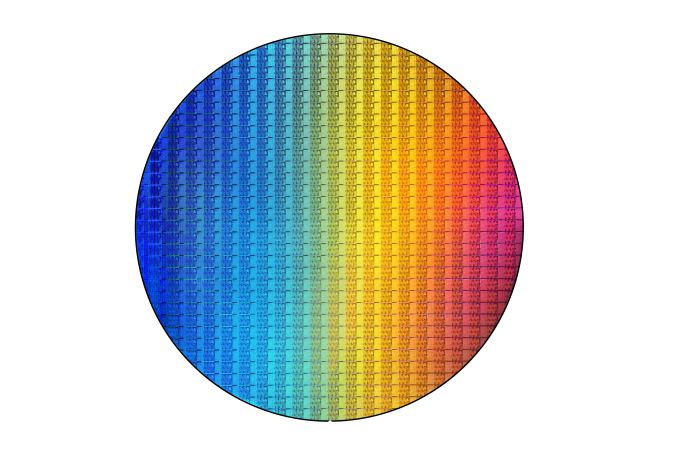
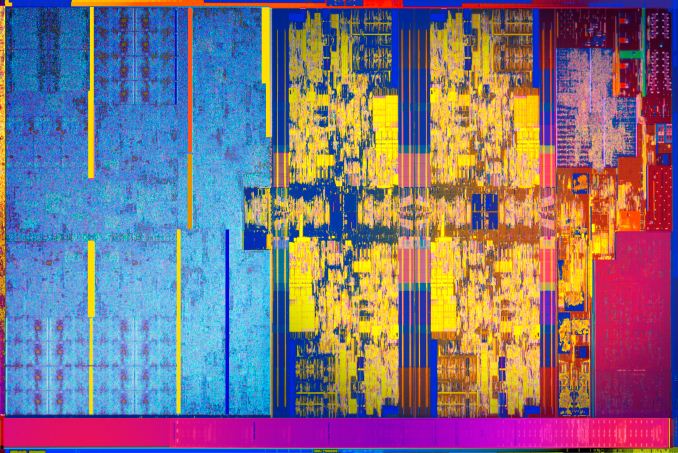
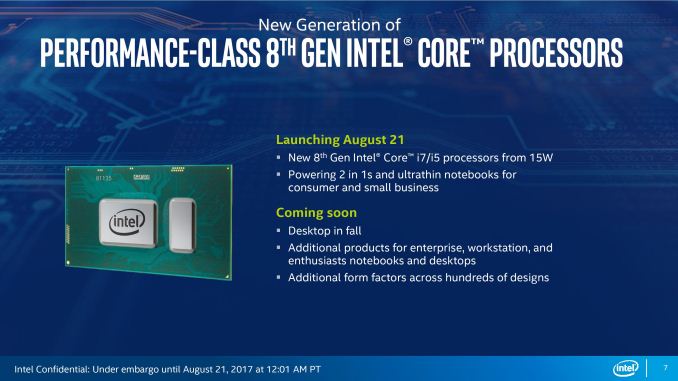
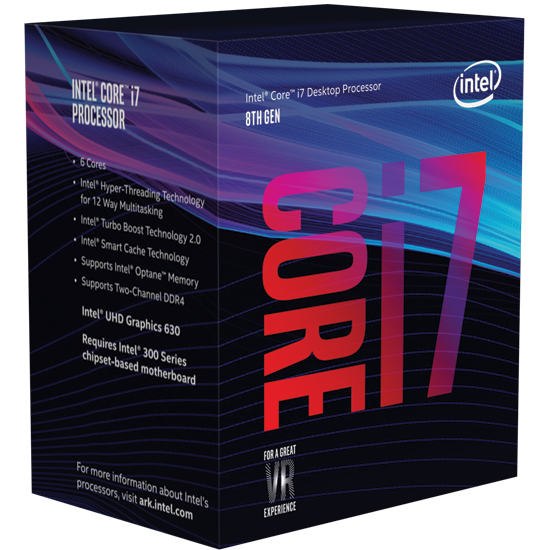
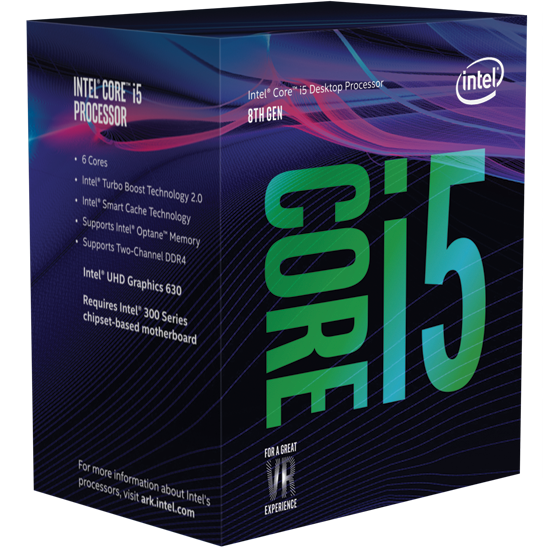
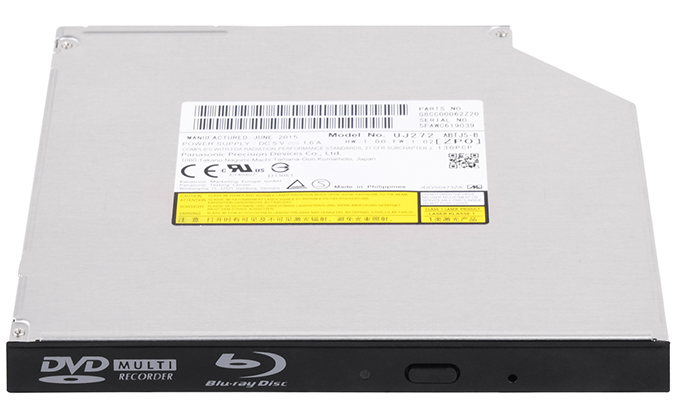

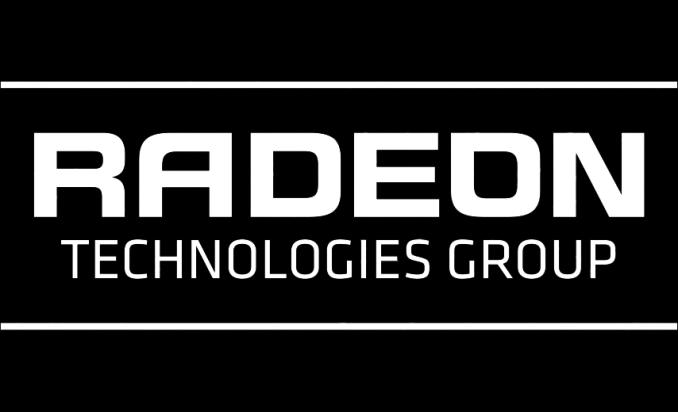



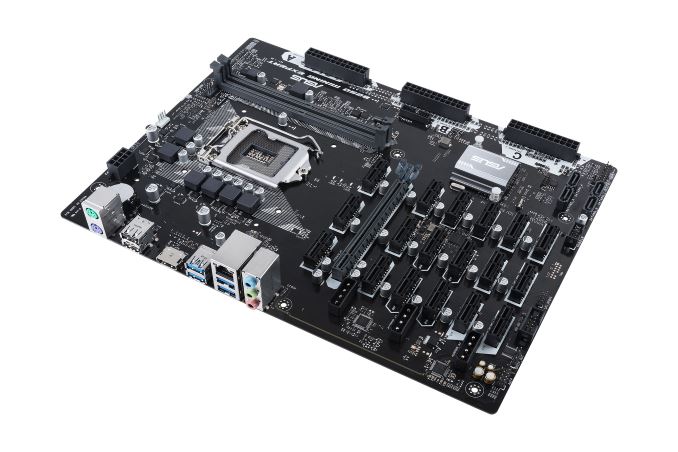
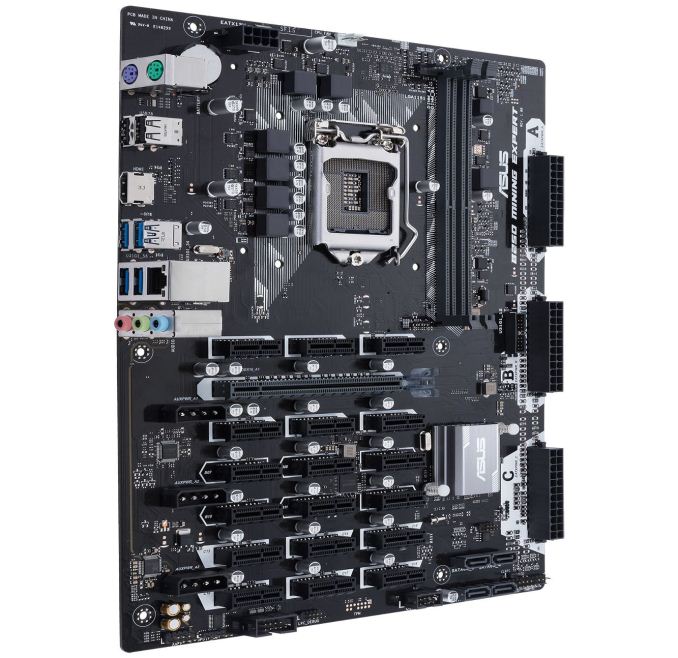
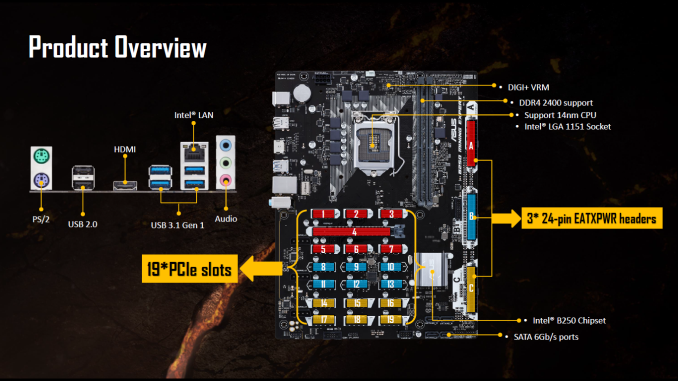
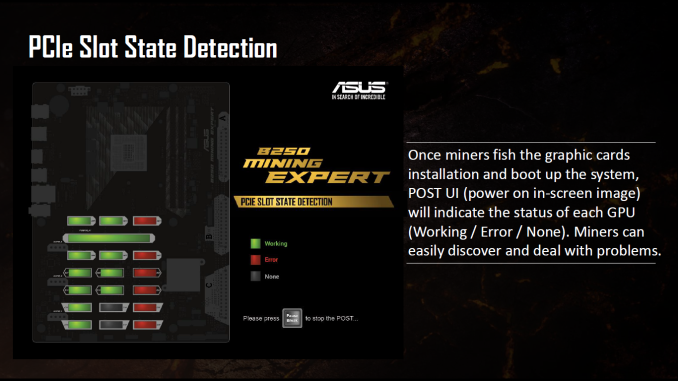
















Bookmarks